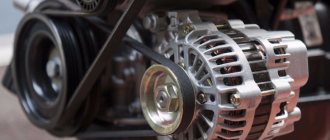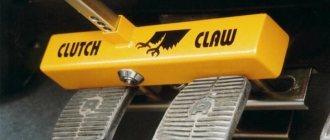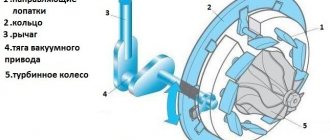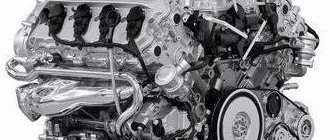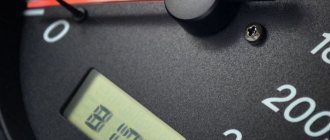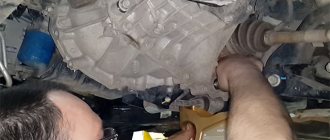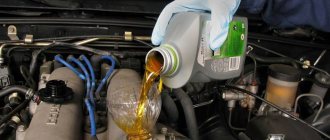What is a tachograph?
A tachograph is a specialized device that is installed on board a vehicle and provides continuous recording of information about the vehicle’s speed limit, route, mileage for a certain time period, short stops and long-term parking.
The tachograph is installed exclusively by certified workshops, the details of which are in the relevant list of Roskomnadzor. Installing and configuring the operation of equipment independently or with the help of craftsmen who do not have permission for this type of activity is not allowed - penalties are provided for this.
Features of the process of calibration of metering devices
In addition to recording information, the device also serves as a measuring device. As you know, devices with this function require mandatory calibration.
This process involves adjusting the change factors so that the reported number of kilometers traveled and speed readings exactly match the actual mileage and speed.
The device is calibrated
- When installing the device for the first time.
- If there are deviations of the built-in clock by twenty minutes or more.
- After repair work carried out on the device.
- After repair work carried out on the measurement sensors.
- If the sealing element is missing or damaged.
- If there are changes in the basic characteristics of the truck.
- Two years after the calibration procedure.
When the device is initially installed, an initial calibration process must be performed. Deadline: a week from installing the metering device or receiving the vehicle registration number.
Why is everything so strict?
Tachograph data is recorded in memory and cannot be corrected or deleted. Information about any manipulations with the tachograph aimed at correcting the information is immediately recorded and becomes available to regulatory services. Based on the readings recorded by the tachograph, you can obtain information about the period of work and rest of the person driving the car. Therefore, the tachograph is called a flight recorder, as well as a car “black box”.
Seals are installed on all mating components of the device. The tachograph is activated for a specific vehicle and calibrated.
What types of devices are there?
Until now, tachographs have been produced in two versions - analog and digital. The first ones are being taken out of service; today their use is prohibited by law. This decision by the authorities is due to the fact that the operating features of an analog tachograph allow for the possibility of data correction.
Digital tachographs are more advanced. The operating principle of these devices is as follows. When the car engine starts and the driver is identified (it is necessary to insert a digital chip card into the body of the on-board recorder), the speed sensor located in the transmission is activated.
How it works
While the vehicle is operating, sensor data enters the integrated memory of the device. They are stored both in the built-in memory and on a chip card, which must remain in the device body all the time the vehicle is operating. According to the principle of operation, digital devices from different manufacturers, models, and modifications are similar to each other.
It is recommended to upload information to a third-party medium (for example, to computer memory) every 28 days - this way you will ensure the correctness of the information received. It is advisable to save the data received by the tachograph for two years - they may be required for verification by regulatory services, resolving controversial issues and other purposes. Any attempts to open the device or otherwise interfere with its operation cannot be hidden; such actions are subject to administrative penalties in the form of a fine.
Device
In appearance and type of connector, a modern tachograph is somewhat reminiscent of a familiar car radio. By the way, this device can easily be placed in an existing 1-DIN bay.
But there is another form of manufacturing - based on the model of a speedometer (made round). But regardless of the shape, the details of the device differ slightly.
The tachograph is based on:
Printing device.
Its task is to display the accumulated information on paper. Here, printing on thermal tape is most often used (as in conventional cash registers).
Screen with buttons.
Simplifies the interaction between the driver and the tachograph, allowing maximum use of the device’s functionality.
GPS modem.
Transfers information to the server, where the received data can be stored for several months, or even years (it all depends on the tasks assigned).
Topographic map reader.
Designed to recognize one or another crew member.
Motion Sensor.
Transmits all information in the form of special ciphers. Consequently, it will not be possible to modify or change the transmitted data even if you want to. If such attempts take place, they are recorded in the tachograph memory.
But that's not all. The device itself contains a special cryptographic module – the so-called CIPF unit. It has a built-in receiver that “cooperates” with the GLONASS positioning system.
The device is connected to the on-board network and starts after the engine starts. After this, the system performs its assigned speed and time control functions.
Built-in sensors act as meters; opening or dismantling them is strictly prohibited.
Why are tachographs needed?
Tachographs collect detailed information not only about the main indicators of the vehicle, but also about the work of a particular driver. Such information helps to control and analyze personnel data, and, accordingly, to optimize the operation of the vehicle fleet and minimize the risk of emergency situations.
They have several tasks:
- the device is synchronized with navigation equipment, therefore it allows you to perform GPS monitoring of vehicles, receive up-to-date information on speed and actual mileage (it is considered more accurate compared to speedometer and odometer readings);
- use of data recorded by the tachograph as evidence when resolving controversial issues between the driver and traffic police officers or other regulatory services;
- assessment of the performance of enterprise personnel and logistics solutions. Based on the information received by the tachograph, the vehicle owner can build more convenient routes, optimize the operation of the vehicle fleet, and, accordingly, reduce vehicle maintenance costs;
- obtaining a clear picture of the cost of operating vehicles, eliminating its misuse by personnel;
- safety of the enterprise’s property – due to more rational management of vehicles. Knowing that the operation of the car is monitored and controlled, drivers will not allow speeding or other violations.
On what vehicles is a tachograph installed?
The obligation to install a tachograph arises if the vehicle is operated for profit - commercial activity.
Motor vehicles subject to tachoraphic control can be divided into categories:
- Buses with more than 8 seats.
- Trucks with a carrying capacity of 3.5 - 15 tons.
Owners of cars transporting their own cargo are not subject to the above requirement, however, those who periodically derive commercial benefits from their trips are obliged to equip their vehicle with a tachograph with the OUT function.
Enabling the mode is necessary if the vehicle is not registered as commercial.
How to operate the equipment
The algorithm for working with a tachograph is extremely simple:
- We check the functionality of the device and the presence of the required amount of paper in the printer;
- insert the chip card into the device slot until a characteristic click is heard - this is necessary to activate the flight recorder;
- we go through the authentication process, the corresponding buttons on the dashboard light up, the display shows the data of the person driving the vehicle;
- upon completion of authorization, enter information about the starting point of the route into the tachograph;
- we start the engine.
During vehicle movement, all data is recorded automatically. Upon arrival at the destination or parking area, the driver must:
- enter the destination (parking) data into the tachograph;
- remove the chip card from the device slot.
After this, when inserting the chip card, you must indicate the previous period as “rest”, otherwise the parking time will be recorded as working time, such an error is considered a violation. When parking your car for a short time, you don’t have to remove the card, but you should set the tachograph to the “rest” mode, otherwise the working time will be recorded./
How to use a tachograph correctly to avoid fines
The rules for operating tachographs are regulated by law. Administrative liability is provided for their violation. It is impossible to know the entire legislative framework, but it is important to remember a few key points:
- transport does not depart without such devices. It is also prohibited to operate the machine if the tachograph is faulty. Responsibility for ignoring this norm falls on both the person driving the vehicle and the owner of the vehicle (company or individual entrepreneur);
- the tachograph is activated immediately before leaving the line;
- The driver's individual chip card is not transferred to third parties. A person driving a motor vehicle has no right to use someone else’s ID;
- Opening tachographs is prohibited by law. If it is discovered that seals have been broken or other attempts to interfere with the operation of the device, representatives of the control service will issue a fine;
- The driver is obliged to observe working hours and rest in accordance with labor standards. If the inspection reveals an excess of the norm, the driver will be held liable;
- access to information recorded by the tachograph is provided to employees of regulatory services upon request. That is why it is necessary to constantly monitor the availability of paper in the printer. It is advisable to always keep a supply of thermal paper in the machine;
- The device must be calibrated in accordance with regulations. Calibration means measuring the characteristics of a vehicle and adjusting the device to the measured values. This procedure is carried out by employees of a specialized service;
- If the device fails, you must immediately contact the service department. If a breakdown occurs on the route, you should return to the base or drive to the nearest parking lot and immediately contact the service.
Installation Rules
Installation of the tachograph is carried out exclusively in specialized service centers and workshops. In this case, the above-mentioned institutions must have a license from the FSB and a mark from the Ministry of Transport. Otherwise, there is a high probability of incorrect installation of the specified device with all the ensuing consequences.
In addition, in the event of breakdowns or failure of the device, the carrier will lose warranty repairs and will have to fix the malfunction out of his own pocket.
Before installing the tachograph, you must first choose the optimal location for it. Considering that you will have to use the device almost every day, you need to take care of its accessibility. It is also necessary to ensure that it is securely fastened to prevent it from breaking due to a fall.
Article on the topic: The right choice of built-in seat heating
The law prohibits installing a tachograph yourself. Nevertheless, for general development, it would be nice to get acquainted with some of the nuances of its installation.
The tachograph installation algorithm is as follows:
- the suitability of the standard speedometer and vehicle speed sensor is analyzed;
- if necessary, the speedometer and speed sensor are replaced;
- wiring is installed connecting the recorder, speedometer and speed sensor;
- the proper operation of the recording device is checked;
- the device is activated and sealed;
- finishing and calibration is carried out.
This procedure does not take much time. As a rule, the carrier will have to spend from 2 to 4 hours.
What are the benefits of devices for drivers?
The main advantages of equipping vehicles with tachographs include:
- increasing the responsibility of the company's driving staff. Each driver is issued an identifier (chip card). This makes it possible to track and control the actions of a specific employee throughout the entire route of the vehicle. The driver knows that he is subject to personal responsibility, and this disciplines him;
- increasing the profitability of the enterprise - by optimizing the costs of maintaining a fleet of vehicles, the risk of fuel drainage or the use of company vehicles for personal purposes is reduced to zero;
- legal insurance for both staff and employer. The data obtained by the tachograph can be used in labor disputes related to rationing and wages. Neither the driver nor his employer will be able to make unfounded claims against each other. In addition, the employer will be able to assess the driving style of each hired employee and determine the level of his reliability and integrity.
And, of course, flight recorders are sources of data that are used in accident investigations. With their help, you can objectively assess the situation and identify those responsible.
